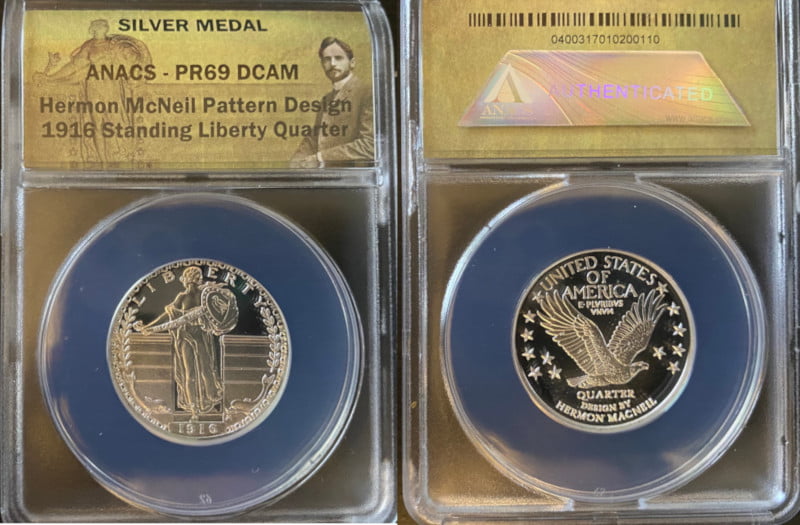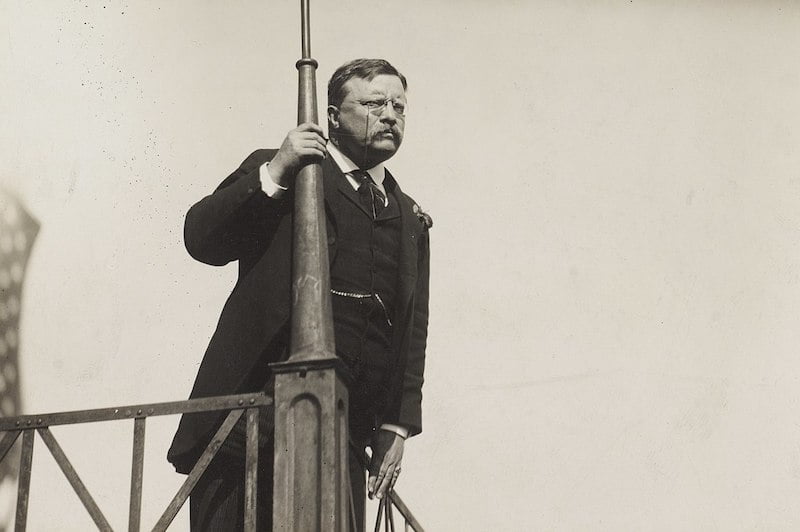Theodore Roosevelt has long had a reputation as one of toughest, most badass Americans to ever serve as President. The guy who gave us “speak softly and carry a big stick,” Roosevelt epitomized the kind of alpha male mentality that so many Americans aspire to. Always on the look for action, the youngest man to ever become President fought in wars for fun, shrugged off assassination attempts with aplomb and even changed the rules of football for the better.
You’d think a guy like that would be the last person to complain about the lack of aesthetic beauty in our nation’s coinage and then do something about it.
You’d be wrong. And thanks to him, we ended up with some of the best looking coins in our nation’s history.
Prior to Roosevelt’s ascension, American coins were utilitarian in design and, with a few exceptions, weren’t much to look at. Many even had a unifying theme that made them look like different sizes of the same coin. For instance, when Roosevelt became President, the Barber head design was still in use for dimes, quarters and half-dollars. And before that, we had Seated Liberty half dimes, dimes, twenty cent pieces, quarters, half dollars and dollars.
I think the state of our coinage is artistically of atrocious hideousness. Would it be possible, without asking permission of Congress, to employ a man like [Augustus] Saint-Gaudens to give us a coinage which would have some beauty?
Roosevelt to Leslie Mortier Shaw, Secretary of the Treasury, Dec. 27, 1904.
These efforts led to the much-acclaimed designs on the country’s gold coinage, in particular the famed Saint-Gauden’s Double Eagle — a coin widely regarded as the most beautiful in American history — and one of my personal favorites, the Indian Head gold eagles. Saint-Gauden’s original design, which provided for an ultra high relief finish that made the coin really pop, was found to be impractical for mass production. As such, Mint officials, led by one Charles Barber, the designer of the aforementioned Barber head coins, were forced to come up with a lower relief version.
By 1915, Roosevelt was long gone from the White House (but not before running as a Progressive in 1912 and doing better than any other third-party candidate in American history) and Saint-Gaudens had died. Nevertheless, the commitment to aesthetic beauty remained, as Mint officials decided to give the dime, quarter and half dollar much-needed makeovers.
Changing coin designs usually requires passage by both Houses of Congress and the signature of the President. However, under an 1890 law, the Secretary of the Treasury is allowed to unilaterally order a new design for a coin still in circulation at least 25 years after it was first adopted or approved. The Barber dime, quarter and half-dollar had been approved in 1891, meaning the Mint could replace all three starting in 1916.
Mint Director Robert Woolley gave Barber first crack at designing the new coins, but his sketches were rejected by the U.S. Commission on Fine Arts. Instead, the Commission solicited designs from sculptors Adolph Weinman, Hermon MacNeil and Albin Polasek, selecting Weinman’s design for what would become known as the Mercury Dime and Walking Liberty Half Dollar and hiring MacNeil for what would become the Standing Liberty Quarter.
Of the “Class of 1916,” the Standing Liberty Quarter has long been my favorite. They were also some of the first coins in my collection as I remember buying several from a flea market in Pittsburgh after they caught my eye. Bearing one of the most appealing and intricate designs in American numismatic history, the Standing Liberty Quarter has been rightly acclaimed as one of the most beautiful coins of all time.

MacNeil’s original design is actually more elaborate than the version that made it to the public. Featuring Lady Liberty with a bare breast exposed holding an olive branch in one hand and a shield in the other, the coin also contained ears of wheat running along the bottom left and right edges of the obverse leading to a pair of dolphins along the bottom edge. MacNeil’s design was intended to represent the country’s desire for peace at a time when World War I was already underway in Europe while conveying its willingness to defend itself, if necessary. The dolphins represented the Atlantic and Pacific oceans – perhaps not coincidentally, they happened to mark the U.S.’s continental borders.
The provocative and highly intricate design touched some nerves – particularly when it came to Lady Liberty’s exposed breast. The conventional story is that the original 1916 design, which featured the wardrobe malfunction in question, caused such an outrage that subsequent issues featured the offending part covered up. However, historians have disputed that, noting that the “controversy” was greatly exaggerated.
The bare breast is not mentioned in contemporary documents or in a negative way. The “massive opposition” so greatly promoted is completely false. There are equivalent or more revealing images all over government buildings in state capitals as well as Federal buildings.
Roger Burdette, quoted in Coin Week.
The coin was re-designed in 1917 to add, among other things, chainmail covering up the breast (the change didn’t take effect until later in the year, so approximately 12.5 million original style 1917 quarters, complete with exposed breast, were minted). But, as historians point out, that had less to do with puritanical reasons than the fact that the U.S. was inching closer to World War I, and the chainmail underscored that new reality.
The other issue with the Standing Liberty quarter is that they wear down easily, so it’s hard to find circulated coins in good condition. Additionally, the design proved to be so delicate and complex that it was hard to manufacture consistently. Indeed, those factors, plus a desire to honor George Washington, brought an end to the Standing Liberty Quarter in 1931.

The Mercury dime is another coin I collected when I first got into numismatics. After all, in addition to being good looking, Mercury dimes are relatively affordable — notwithstanding a few rare specimens, including the 1916-D, which can cost thousands of dollars.
The Mercury Dime is also unique in the sense that it’s actually a misnomer. Weinman designed the obverse to portray Lady Liberty wearing a Phrygian cap representing freedom. However, most people thought it was a bust of the Roman messenger god Mercury — giving the dime its colloquial name. The Roman fasces symbol on the reverse only reinforced the confusion. (Inconveniently, the fasces symbol and its name would be co-opted by Benito Mussolini and his Fascist Party a few years later, causing some historians and numismatists to worry about that commonality.)

Nevertheless, the design proved to be very popular. Many in the numismatic community praised the dime when it was first released in 1916. “The new dime is the best piece of work that the United States Mint has turned out in a century,” J.W. Scott said in the December 1916 issue of The Numismatist. “The new dime by Adolph Weinman is without doubt the finest example of our new coinage which was begun in 1907 with the advent of the $20 and $10 gold pieces,” Howland Wood said in the same issue of The Numismatist. “Undiluted praise should be given to Mr. Weinman, and we trust that the other two denominations of the silver coins will equal if not exceed in merit the new dime.”
The Mercury dime lasted until 1945, whereupon it was replaced with the FDR dime that remains in circulation to this day. The design was resurrected for the Palladium Eagles program in 2017. Thankfully, they omitted the fasces this time.
Perhaps the most enduring of the Class of 1916 was the Walking Liberty Half Dollar. Also created by Weinman, the Walking Liberty has long been regarded as one of the most beautiful and popular designs in American history. No greater an authority than Cornelius Clarkson Vermeule III called it “one of the greatest coins of the United States—if not of the world.”
“In our opinion the new designs form the most attractive set of silver coins ever issued by this or any other government,” The Numismatist said in its review in January 1917.
As with the other two, Walking Liberty Half Dollars were some of the first coins in my collection. They’re relatively affordable and, unlike their Class of 1916 counterparts, there are no real rarities or key dates when it comes to Walking Liberties. So it’s possible for collectors to obtain a compete set at a reasonable price.

Instead, the challenge is to find Walking Liberty Half Dollars in good condition. Like the Standing Liberty Quarter, the half dollar was plagued by design issues that caused the coin to wear down easily and made it difficult for the Mint to strike them properly.
Most dates, however, come weakly struck, particularly on Liberty’s left hand and leg, head and skirt lines and on the eagle’s breast and leg feathers. Sharply struck coins often command substantial premiums. In an attempt to improve the striking characteristics of the design, some minor modifications were made by Chief Engraver George T. Morgan in 1918 and 1921 and again by Assistant Engraver John R. Sinnock in 1937 and 1938. None of the revisions seemed to help, as even later issues are often weak in the central parts of the design.
NGC website.
The Walking Liberty Half Dollar lasted until 1947, when it was replaced by the Benjamin Franklin Half Dollar the following year. But like many great designs, the Walking Liberty didn’t go away permanently. When Congress and the Mint came up with the Silver Eagles program, they brought back the Walking Liberty design to great acclaim.
In fact, the only design from the Class of 1916 they haven’t resurrected is the Standing Liberty [the Mint did release gold versions of these three coins in 2016 to commemorate their centennial]. Maybe they’ll redesign the platinum eagle at some point and give it the kind of classic look it currently lacks. Maybe they’ll use the design for the next bullion program (maybe rhodium?). Or maybe they’re holding off because of the backlash that would surely ensue if they resurrected the original exposed breast version of the coin.
Or maybe they should just put Theodore Roosevelt on those coins. It only seems fair. After all, if it weren’t for him, we probably would have been stuck with yet another Liberty Head variant instead of the beauties we got starting in 1916.

